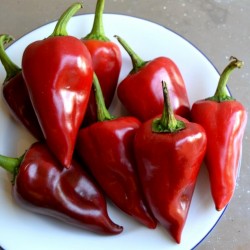Menu
-
MenuPrécédent
- Home
-
Catégories
-
-
Catégories
-
Graines de Légumes
-
Variétés par pays
- Variétés d'Arménie
- Variétés de BiH
- Variétés de Croatie
- Variétés de France
- Variétés d'Allemagne
- Variétés de Grèce
- Variétés de Hongrie
- Variétés d'Inde
- Variétés d'Italie
- Variétés du Japon
- Variétés de Macédoine du Nord
- Variétés du Pérou
- Variétés de Russie
- Variétés de Serbie
- Variétés de Slovénie
- Variétés d'Espagne
- Variétés de Thaïlande
- Variétés de Turquie
- Variétés des USA
- Graines De Tomates
- Graines de maïs
- Famille de gourdes
- Famille de haricots
- Graines de concombre
- Graines de Poivron
- Famille de carottes
- Famille oignon
- Graines de laitue
- Famille de pommes de terre
- Famille de chou
- Graines de radis
- Betterave famille
- Graines de Pastèque
- Graines de Melon
- Graines de chou-fleur
- Famille de tournesol
-
Variétés par pays
- Graines de Fruits
- Graines de Piments
- Graines Plantes Médicinales
- Graines de plantes grimpantes
- Graines Arbres Bonsai
- Graines de Palmiers
- Graminées Ornementales
- Graines de Tabac
-
Graines de Légumes
-
-
-
-
- NOUVEAUX PRODUITS
- Créer un compte
- Livraison Paiement
- FAQ
- Accueil
-
- Graines de Légumes
- Variétés par pays
- Variétés de Macédoine du Nord
- Variétés de Croatie
- Variétés de Turquie
- Variétés de BiH
- Variétés du Japon
- Variétés d'Inde
- Variétés d'Arménie
- Variétés de France
- Variétés de Slovénie
- Variétés de Serbie
- Variétés de Grèce
- Variétés de Russie
- Variétés d'Italie
- Variétés d'Espagne
- Variétés des USA
- Variétés d'Allemagne
- Variétés du Pérou
- Variétés de Thaïlande
- Variétés de Hongrie
- Graines de chou-fleur
- Graines de Melon
- Graines de Pastèque
- Famille de tournesol
- Betterave famille
- Graines de radis
- Graines De Tomates
- Graines de maïs
- Famille de gourdes
- Famille de haricots
- Graines de concombre
- Graines de Poivron
- Famille de chou
- Famille de pommes de terre
- Famille oignon
- Graines de laitue
- Famille de carottes
- Variétés par pays
- Emballage et articles
- Mycélium aux champignons
- Bulbes de plantes
- Épices Biologiques
- Plantes Ayurvédiques
- Graines hybrides F1
- Graines de banane
- Pas de PayPal et paiement par Carte X
- Graines de plantes Géantes
- Plantes résistantes au froid
- Graines de bambou
- Moules à fruits et légumes
- Grands Sachets De Graines
- Graines de Fruits
- Graines de Piments
- Graines Plantes Médicinales
- Graines de plantes grimpantes
- Graines Arbres Bonsai
- Graines de Palmiers
- Graminées Ornementales
- Graines de Tabac
- Livraison Paiement
- Instructions de semis
- Soins des plantes
- Graines Plante aquatique
- Graines de Cactus
- Graines de Fleurs
- Graines de Légumes
Derniers Avis Produits
These peppers came all the way from eastern Europe and took a while at no f...
Par
 Fitim Berani sur 21/09/2023
Fitim Berani sur 21/09/2023
Achat Vérifié
dernières commandes
- Tanja, Beograd, Serbia
- Alaa, Alwajh, Saudi Arabia
- ionescu, valu lui traian, Romania
- Lasse, 2900, Norway
- Pete, Cleves, United States
- Stef, Waalwijk, Netherlands
- Sonia, Minervino di Lecce, Italy
- Adrian, Ingolstadt, Germany
- CORINNE, NOTRE DAME DE LONDRES, France
- Dušan, KRAVANY NAD DUNAJOM, Slovakia
- Arno, Ehrenkirchen, Germany
- Costas, LARNACA , Cyprus
- Fulvio francesco, Santa Domenica Talao, Italy
- william, Dun, France
- Aymeric , Saint tricat, France
- Ricard, Sant Celoni, Spain
- Maureen , Enniscorthy Co Wexford , Ireland
- Paul, St. Vigil in Enneberg (BZ), Italy
- Ricardo jorge , Viseu , Portugal
- Radosav, Kragujevac, Serbia
- Sylvie, Neyruz, Switzerland
- Julien, Scionzier, France
- Zoran, Vinca, Serbia
- Josef, Hochdorf-Assenheim, Germany
- Davide, London, United Kingdom
- Kimberly, Victoria, Gozo, Malta
- Saša , Beograd, Serbia
- Ewa, Galway, Ireland
- Ioannis , Kato Achaia, Greece
- Samuele, Milano, Italy
Meilleures ventes
Il y a 882 produits.
Affichage 385-396 de 882 article(s)
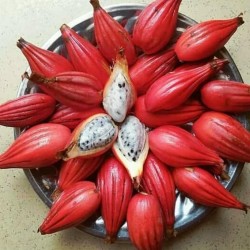
Graines de Ginguenga,...
Prix
3,45 €
SKU: V 66
Seeds Gallery Com,
5/
5
<h2><strong>Graines de Ginguenga, Fruits Célestes (Aframomum alboviolaceum)</strong></h2>
<h2><span style="color: #ff0000;" class=""><strong>3 graines par sachet.</strong></span></h2>
<p>Aframomum alboviolaceum, connue en anglais sous le nom de large amomum, Aframomum africanum fruit ou encore grape-seeded amomum, est une espèce de plantes dicotylédones de la famille des Zingiberaceae, originaire d'Afrique tropicale.</p>
<p>C'est une plante herbacée, vivace, rhizomateuse, parfois utilisée comme plante alimentaire ou médicinale.</p>
<p>Aframomum alboviolaceum est une plante à rhizomes2 rampants, profondément enfouis dans le sol, qui produit des tiges feuillues arrivant jusqu'à 3 mètres de haut3. Elle est collectée directement du milieu naturel. Sa culture est parfois considérée comme étant vivrière4. Ses fleurs sont de couleurs mauve pâle et blanc comportant une tache jaune. Cette plante donne naissance à un fruit à la saveur acidulée : le matungulu, parfois nommé « oignon de brousse » en français. La pulpe de ses fruits est particulièrement riche en éléments minéraux, spécialement le potassium5.</p>
<p><strong>Utilisation</strong></p>
<p>Cette plante a plusieurs utilisations allant de l’alimentation à l’utilisation médicinale : ses feuilles sont utilisées comme épice et ses graines à des fins stomachique et vermifuge5.</p>
V 66 (3 S)

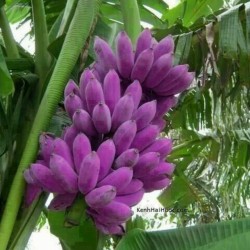
Graines de Banane Bleues...
Prix
4,50 €
SKU: V 125
Seeds Gallery Com,
5/
5
<h2><strong>Graines de Banane Bleues Birmanes (Musa itinerans)</strong></h2>
<h2><span style="color: #ff0000;"><strong>3 graines par sachet.</strong></span></h2>
<p>Cette banane rare et de taille moyenne se trouve en Birmanie, dans le nord de la Thaïlande, au Laos et au Vietnam. Il était autrefois associé aux musa acuminata et au balbisian musa, mais on pense maintenant qu'il est plus proche du musa et similaire à la variété récemment décrite, le guangdongensis, mais ce n'est pas le même qui grossit considérablement et développe de nouveaux boutons, 2 à 3 mètres de la plante principale (plante mère).</p>
<p>Les fruits mûrs sont bleuâtres à violets, petits et sont très appréciés dans la cuisine thaïlandaise.</p>
<p>Il n'est actuellement pas connu en culture, mais il est peu probable qu'il pose des problèmes particuliers pour la culture sous des climats tropicaux et / ou tempérés.</p>
<p>C'est une variété plus résistante au froid, présente dans son habitat d'origine à des altitudes pouvant aller de 200 à 1800 mètres le long de routes escarpées. Il peut résister au gel saisonnier, en émergeant rapidement de nouvelles feuilles au début du printemps.</p>
<p>Note: Cette espèce a été traitée par certains comme le musa guangdongensis récemment découvert, mais ce n'est pas la même espèce.</p>
<p> </p>
<p>En culture, il nécessite des conditions adaptées aux fougères plutôt qu’aux bananiers ordinaires et réguliers, en raison de son habitat naturel.</p>
<p> </p>
V 125 (3 S)


Variété d’Italie


Graines de Haricot Sabre...
Prix
4,95 €
SKU: VE 228
Seeds Gallery Com,
5/
5
<h2><strong>Graines de Haricot Sabre Géantes blancs "Shironata Mame" (Canavalia gladiata)</strong></h2>
<h2><strong><span style="color: #ff0000;">3 graines par sachet. </span> </strong></h2>
<p><strong>Variété japonaise "Shironata Mame"!</strong> Le haricot sabre (Canavalia gladiata) est une plante cultivée dans les régions tropicales et subtropicales d'Afrique et d'Asie. Fruit immature des plantes 'Canavalia', mangé en ragoût ou séparément.</p>
<p>Ce haricot japonais de culture tropicale est récolté lorsque les gousses sont jeunes et tendres. Les gousses vertes épaisses et brillantes sont plates, ont un bord et un goût de haricots. Les grandes vignes poussent rapidement.</p>
<p>Les gousses mûrissent en Chine en octobre. Les gousses légèrement aplaties, légèrement en forme de sabre, ont une longueur de 20 à 40 ou parfois même de 50 centimètres. Les gousses contiennent 8 à 20 graines.</p>
<p>La graine relativement grosse est elliptique-oblongue, aplatie de 1 à 3,5 centimètres de long et de 1,5 à 2 centimètres de diamètre. Le tégument est généralement brun crème ou brun rougeâtre, rarement noir, rose ou blanc (Canavalia gladiata).</p>
<p>La masse de milliers de grains est relativement importante entre 1800 et 2100 g.</p>
<p>Nous vous enverrons des graines avec le beau message de notre choix en cadeau.</p>
VE 228 (3 S)

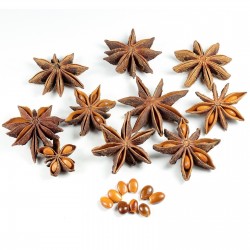
Graines de badiane chinoise...
Prix
3,50 €
SKU: MHS 116
Seeds Gallery Com,
5/
5
<h2 class=""><strong>Graines de badiane chinoise ou Anis Etoilé (Illicium verum)</strong></h2>
<h2><span style="color: #ff0000;"><strong>3 graines par sachet.</strong></span></h2>
<p>La<span> </span><b>badiane chinoise</b><span> </span>ou<span> </span><b>anis étoilé</b><span> </span>est le fruit du badianier de Chine. Il se compose d'un follicule ligneux à huit carpelles contenant chacune une graine brillante. Il forme ainsi une étoile à huit branches particulièrement caractéristique, d'où le nom vernaculaire d'anis étoilé. Les fruits sont cueillis verts avant d'être séchés au soleil où ils prennent une couleur marron rouge.</p>
<p>Les Chinois la connaissent sous deux différents noms, en premier lieu ?? (Dà Liào, traduit littéralement par gros fourrage), mais ses huit lobes donnèrent aussi le nom chinois qui peut être traduit littéralement par «huit cornes» (??<i>, mandarin</i> : bā jiǎo;<span> </span><i>cantonais</i> : baat gok ; ? «huit», ? «cornes»).</p>
<h2><span class="mw-headline">Appellations</span></h2>
<p>L'anis étoilé est aussi appelé anis de Sibérie, fenouil de Chine ou au Japon (variété toxique)<span> </span><i>Shikimi</i>,<i>Shikimi no ki</i>,<span> </span><i>Hana Shik mi</i><span> </span>peut-être rédigé<span> </span><i>Sikimi</i>,<span> </span><i>Skimi</i>, termes qui pourraient provenir du mot<span> </span><i>Ashikimi</i>(fruit du diable).</p>
<ul>
<li>Au Japon, on l'aurait aussi nommé<span> </span><i>Hana no ki</i><span> </span>dans la province de Harima et<span> </span><i>Koshiba</i><span> </span>dans la province d'Enshu-Totomi.</li>
<li>En Chine, on l'appellerait<span> </span><i>Mang-tsao</i>.</li>
<li>Il était et est toujours utilisé en<span> </span>médecine<span> </span>respectant les traditions (eupeptique, carminatif, diurétique, tonicardiaque, ... ). Il produit une huile principale riche en<span> </span>anéthol, estragol,<span> </span>linalol, terpinéol, polysaccharides lipides - flavonoïdes.</li>
<li>On le trouve dans les tisanes et la composition d'épices dont le fameux mélange «5 épices», des currys, etc.</li>
<li>Il a progressivement remplacé dans les apéritifs anisés industriels l'anis vert d'antan.</li>
</ul>
<h2><span class="mw-headline">Production</span></h2>
<div class="thumb tleft">
<div class="thumbinner"><img alt="" src="http://www.bonneplante.com/illustrations/180px-illicium_verum_in_hdr.jpg" width="180" height="135" class="thumbimage" />
<div class="thumbcaption">
<div class="magnify"><img src="http://www.bonneplante.com/illustrations/magnify-clip.png" width="15" height="11" alt="" /></div>
Fruit séché avec des carpelles ouverts, et contenant des graines</div>
</div>
</div>
<p><span class="need_ref" title="Ce passage nécessite une référence.">En 2007, la production mondiale de badiane a été de<span> </span><span>40 000 tonnes</span>.</span><sup title="Ce passage nécessite une référence."></sup></p>
<p><span class="need_ref" title="Ce passage nécessite une référence.">90% de la production mondiale de badiane provient de la province du Jiangxi en Chine, où elle fait vivre 10 millions de personnes</span><sup title="Ce passage nécessite une référence."></sup>. Le reste est produit au Viêt Nam, au Cambodge, au Laos, au Japon ainsi qu'aux Philippines.</p>
<p>Les récoltes de badiane ont lieu deux fois par an, en avril et octobre.</p>
<h2><span class="mw-headline">Utilisation alimentaire</span></h2>
<p>L'anis étoilé est une épice à l'arôme plus puissant que l'anis vert<span> </span>qui entre dans la composition du mélange de la poudre aux cinq épices (???, wǔxiǎngfěn) : badiane, poivre du Sichuan,<span> </span>cannelle,<span> </span>clou de girofle, graines de<span> </span>fenouil.</p>
<p>L'arôme de la badiane est essentiellement dû à l'anéthol.</p>
<p>Son huile se distingue principalement de l'huile d'anis vert par sa teneur en fenchone et son absence d'isomère de type pseudo-isogeugenol.</p>
<p>Il est utilisé en Europe, surtout dans la fabrication du pastis.</p>
<p>En pâtisserie, il aromatise gâteaux et galettes respectant les traditions de l'ouest de la France (infusé dans du lait). En Allemagne, il est utilisé dans la fabrication des<span> </span>marmelades. Il favorise les digestions complexes, d'où son succès en apéritif, en digestif ou en dessert.</p>
<h2><span class="mw-headline">Propriétés médicinales</span></h2>
<p>L'anis étoilé a des propriétés stomachiques et carminatives. Utilisé en infusion, il supprime les ballonnements et diminue les gaz.<sup id="cite_ref-0" class="reference"></sup></p>
<p>La badiane chinoise est aussi utilisée dans la fabrication de l'acide shikimique. Cet acide qui ne présente aucune activité antivirale sera transformé plusieurs fois avant de devenir le phosphate d'oseltamivir<sup id="cite_ref-1" class="reference"><span class="cite_crochet">[</span>2<span class="cite_crochet">]</span></sup>, molécule active du Tamiflu, médicament antigrippal des laboratoires Roche, utilisé contre la grippe humaine ainsi qu'à défaut d'autre médicament, contre la grippe aviaire et porcine. Le procédé de fabrication ne consiste nullement en une distillation comme pour obtenir de l'huile principale. Cette utilisation pharmaceutique de la badiane chinoise est à l'origine de la flambée de son prix. Cependant, l'oséltamivir pouvant être désormais obtenu à partir de différents procédés (bio-fermentation,<span> </span>synthèse chimique, autres plantes), les prix pourraient être amenés à baisser.</p>
<p>Attention de ne pas confondre, surtout quand elle est en poudre, la badiane chinoise et la<span> </span>badiane japonaise, qui est toxique et dont l'utilisation n'est pas autorisée en France.</p>
<h2><span class="mw-headline">Bibliographie</span></h2>
<ul>
<li>"Herbes et épices", Clotilde Boisvert et Annie Hubert, Albin Michel,<span> </span><small>(ISBN 2-226-00430-0)</small></li>
</ul>
<p><span style="color: inherit; font-family: inherit; font-size: 30px;">How to Grow Star Anise From Seeds</span></p>
<p>Star anise trees (<em>Illicium verum</em>) grow easily from seed. Star anise trees grow in U.S. Department of Agriculture plant hardiness zones 7 through 10 and do best with a soil pH between 4 and 6 that's rich in organic matter. They grow in either full sun or part shade.</p>
<p><span style="color: inherit; font-family: inherit; font-size: 30px;">Preparing and Planting Star Anise Seeds</span></p>
<p>Carefully preparing and planting the seeds will give the best chance of success. Or, store the seeds in moist sand in a sealed plastic bag or container in the refrigerator for up to a month.</p>
<p><span style="color: inherit; font-family: inherit; font-size: 30px;">Step 1</span></p>
<p>Pour seed-starting potting mix into 4- to 6-inch-diameter plastic pots. Fill them to 1 to 1 1/2 inches from the top. Moisten the mix with room-temperature water. Use pots that have drainage holes in them.</p>
<p><span style="color: inherit; font-family: inherit; font-size: 30px;">Step 2</span></p>
<p>Place the seeds into a bowl filled with water. Throw away any seeds that <strong>float</strong> to the surface. They are not viable. Plant only the seeds that sink to the bottom.</p>
<p><span style="color: inherit; font-family: inherit; font-size: 30px;">Step 3</span></p>
<p>Place two or three seeds per pot on top of the moistened potting mix, spaced evenly apart. Cover the seeds with a 1/4 to 1/2 inch of a moistened seed-starting mix. Firm it gently with your fingers to remove air pockets. Set plastic water or soda bottle with the bottom cut out over the seeds. Leave the screw caps on.</p>
<p><span style="color: inherit; font-family: inherit; font-size: 30px;">Step 4</span></p>
<p>Put the containers in bright, indirect light where temperatures stay around 70 degrees Fahrenheit. Moisten the potting mix using a spray bottle with room-temperature water if it begins to dry or set the containers in 1 to 2 inches of room-temperature water for an hour or two. The water will soak up into the germination mix through the holes in the bottoms of the containers.</p>
<p><span style="color: inherit; font-family: inherit; font-size: 30px;">Step 5</span></p>
<p>Remove the screw caps from the tops of the bottles after the seeds germinate. Remove the bottles a week later. The seeds should germinate in <strong>one to two months</strong>.</p>
<p><span style="color: inherit; font-family: inherit; font-size: 30px;">Step 6</span></p>
<p>Pot the star anise tree seedlings up in individual 6- to 8-inch pots when they are 3 to 4 inches tall. Use pots with drainage holes. Pot them up using <strong>peat-based</strong> potting soil. Set them in bright, indirect light and water them with room-temperature water when the top of the potting soil begins to dry.</p>
<p><span style="color: inherit; font-family: inherit; font-size: 30px;">Step 7</span></p>
<p>Grow the star anise plants in their containers for one year. Repot them into containers 1 inch larger when they become pot-bound or when you can see the roots through the drain holes in the bottom of the container. <strong>Set them outdoors</strong> during the day in the summer when there is no danger of frost and the weather is calm and pleasant. Put them in bright shade in an area that is protected from strong winds. Continue to water them when the top of the soil begins to dry.</p>
<p><span style="color: inherit; font-family: inherit; font-size: 30px;">Step 8</span></p>
<p>Plant them outdoors in their permanent positions the following spring after any danger of frost has passed. Begin to get them used to direct sunlight two weeks before planting. Start with an hour of direct morning sunlight and increase the duration by 30 minutes or so every two days. Water them when the top 2 inches of soil feel dry. Plant multiple trees 15 to 20 feet apart. Water them generously right after planting and continue to water them as often as necessary to keep the soil lightly moist.</p>
<script src="//cdn.public.n1ed.com/G3OMDFLT/widgets.js"></script>
MHS 116 (3 S)


Variété du Japon

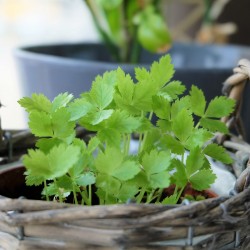
Graines de Persil Japonais...
Prix
1,95 €
SKU: MHS 115
Seeds Gallery Com,
5/
5
<h2><strong>Graines de Persil Japonais (Cryptotaenia japonica)</strong></h2>
<h2><span style="color: #ff0000;"><strong>50 (0,13 g) graines par sachet.</strong></span></h2>
<p>Mitsuba (Cryptotaenia Japonica) est originaire du Japon, où il est une herbe culinaire aux utilisations similaires à celles de persil - peut-être c'est pourquoi il est également connu sous le nom de "persil japonais", parce que l'arôme a peu de </p>
<p>ressemblance avec le persil. Son goût rappelle un peu de céleri vert avec un composant aromatique supplémentaire très distincte. Au Japon, les tiges charnues sont également consommées comme légume-racine. <br />Pack avec env. 100 graines de Mitsuba</p>
<p>En savoir plus: description et entretien</p>
<p>Famille de plantes:</p>
<p>Apiacées</p>
<p>Hauteur de la plante env.:</p>
<p>30 – 60 cm</p>
<p>Couleur des fleurs:</p>
<p>Blanc</p>
<p>Cycle de vie :</p>
<p>Vivace</p>
<p>soleil:</p>
<p>Lieu semi–ombragéplein soleil</p>
<p>Semis et culture</p>
<p>Préculture intérieur :</p>
<p>MarsAvrilMai</p>
<p>Temps de semis à l'extérieur:</p>
<p>MaiJuinJuillet</p>
<p>Température optimale de germination :</p>
<p>12 – 15 °C</p>
<p>Temps de germination (jours):</p>
<p>14 – 21</p>
<p>distance de plantation:</p>
<p>20 x 20 cm</p>
<p>Semer à partir de Mars dans le champ en rangées (25 cm de distance). Seulement légèrement couvrir les graines avec le sol. Aime les endroits ensoleillés et un bon terreau de jardin et peut aussi être cultivé en pots. <br /><br />Picture source: By Mbc [GFDL (http://www.gnu.org/copyleft/fdl.html) or CC-BY-SA-3.0 (http://creativecommons.org/licenses/by-sa/3.0/)], via Wikimedia Commons</p>
<p>Autres noms</p>
<p>Nom botanique:</p>
<ol>
<li>canadensis f. atropurpureacryptotaenia japonicaderinga dissecta</li>
</ol>
<p>Noms allemands :</p>
<p>japanische petersiliejapanpetersiliemitsuba</p>
<p>Noms anglais:</p>
<p>japanese honewortjapanese parsley</p>
<p> </p>
MHS 115 (50)

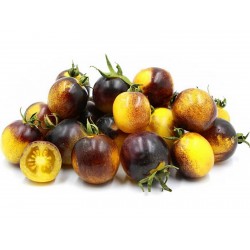
Graines de tomate Wagner...
Prix
1,65 €
SKU: VT 13
Seeds Gallery Com,
5/
5
<h2 class=""><strong>Graines de tomate Wagner Bleu Jaune</strong></h2>
<h2><span style="color: #ff0000;"><strong>10, 20, 50 graines par sachet.</strong></span></h2>
<p>Cette tomate rare et belle provient de l'éleveur Tom Wagner. Wagner Blue Yellow est une tomate accrocheuse rare qui est jaune vif, avec des épaules marbrées bleu foncé. Ils développent la couleur bleu-violet à mesure qu'ils grandissent, et plus chaque tomate reçoit de soleil, plus cette couleur devient profonde. Wagner Blue Yellow est une petite tomate de type salade, bien qu'elle soit toujours plus grosse qu'une tomate cerise avec environ 5-6 cm de taille et 50-90 grammes de poids, et elle a une saveur douce, presque citronnée avec une texture juteuse attrayante. Les fruits mûrissent après 60 à 70 jours. Les plants de tomates Wagner Blue Yellow peuvent atteindre une moyenne de 180 cm et produisent des rendements abondants en fruits ronds tout au long de la saison jusqu'au gel.</p>
<p>Wagner Blue Yellow ne doit pas être confondu avec la tomate <a href="https://www.seeds-gallery.shop/fr/accueil/graines-de-tomates-bleues-bosque-blue.html" target="_blank" title="Graines De Tomates Bleues "Bosque Blue"" rel="noreferrer noopener"><strong>bleue bosque</strong></a><strong>,</strong> qui est une variété totalement différente qui a été lancée par la même ferme en 2011. Wagner Blue Yellow a également été proposée sous le nom de Purple Yellow Light Bulb.</p>
<p>Les tomates Wagner Blue Yellow sont idéales pour les collations fraîches et leur aspect unique en fait un excellent ajout aux salades. Ils peuvent être utilisés dans les salsas fraîches ...</p>
<p>Les tomates bleues comme le Wagner Blue Yellow sont élevées délibérément aux États-Unis pour les bienfaits pour la santé de leur teneur en anthocyanes. Jusqu'au 21e siècle, les tomates cultivées dans les jardins familiaux n'avaient le pigment bénéfique que dans leurs feuilles et leurs tiges, qui sont non comestibles, tandis que seules quelques espèces de tomates sauvages avaient des anthocyanes dans leurs fruits.</p>
<p>Cette année 2019, pour la première fois, nous (Seeds Gallery) avons semé cette tomate et avons été ravis de son goût et de son rendement.</p><script src="//cdn.public.n1ed.com/G3OMDFLT/widgets.js"></script>
VT 13 (10 S)

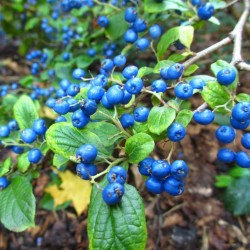
Graines de saphir et de...
Prix
1,95 €
SKU: V 97
Seeds Gallery Com,
5/
5
<h2><strong>Graines de saphir et de baies (Symplocos paniculata)</strong><strong> </strong></h2>
<h2><span style="color:#ff0000;"><strong>5 graines par sachet.</strong></span></h2>
<p>Symplocos paniculata est un arbuste à feuilles caduques appartenant au genre Symplocos et à la famille des Symplocaceae que l'on trouve dans son environnement naturel en Chine, au Japon et au sud de la Corée. Il est cultivé pour ses qualités ornementales et fleurit en juin.</p>
<p>Symplocos paniculata peut atteindre 3 mètres de haut1 en Europe, parfois plus (jusqu'à 6 mètres) dans son environnement d'origine en Asie. Ses feuilles mesurent de 2 à 4 cm de largeur et de 3 à 8 cm de longueur en moyenne. Ses fleurs odoriférantes hermaphrodites sont petites de 2 à 3 cm de longueur, disposées en panicules, et de couleur blanc-crème.</p>
<p>L'écorce de Symplocos paniculata est grise et cannelée.</p>
<p>Ses drupes, de 3 à 8 mm de diamètre en moyenne, mûrissent de septembre à octobre. Leur couleur est d'un bleu brillant et violacé. On peut les consommer en gelée. Les oiseaux en sont friands.</p>
<p>Symplocos paniculata est originaire du nord de la Birmanie, de Cochinchine et du sud-ouest de la Chine, du Japon, et du sud de la Corée, où on le trouve jusqu'à 2 500 mètres d'altitude.</p>
<p>Cet arbuste, lorsqu'il est cultivé, préfère les sols bien drainés et humides et peu les sols calcaires. Il apprécie le soleil et peut croître sous exposition à mi-ombre, mais ne peut pousser à l'ombre. Il supporte les sols acides.</p>
V 97

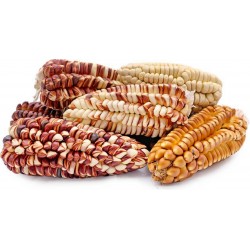
Graines de maïs Sacsa Kuski...
Prix
2,25 €
SKU: P 280
Seeds Gallery Com,
5/
5
<meta http-equiv="Content-Type" content="text/html; charset=UTF-8" />
<h2><strong>Graines de maïs Sacsa Kuski géant péruvien</strong></h2>
<h2><span style="color: #ff0000;"><strong>5 ou 10 graines par sachet.</strong></span></h2>
<p>Variété à gros noyau de maïs de grande culture des Andes, le noyau est de couleur blanc-rouge. <span>Excellent pour la cuisson et la cuisson, très doux et à gros grains, il est donc préférable de le cuire.</span></p>
<p> </p>
<p>L'un des aliments les plus consommés dans la cuisine péruvienne. Ce maïs est planté au Pérou depuis au moins 1200 ans av. Les anciens agriculteurs péruviens ont atteint un degré de sophistication élevé dans la sélection et la création de nouvelles variétés adaptées aux différents terrains et climats.</p>
<p> </p>
<p>Le chroniqueur espagnol du XVIe siècle, Bernabé Cobo, a écrit comment, dans l'ancien Pérou, on pouvait trouver du maïs (appelé localement choclo) dans toutes les couleurs sous le soleil: blanc, jaune, violet, noir, rouge et mélangé. Aujourd'hui, les agriculteurs de la côte péruvienne, des hauts plateaux et de la jungle cultivent plus de 55 variétés de maïs, plus que partout ailleurs dans le monde.</p>
<p> </p>
<p>L’historien autochtone Inca Garcilaso de la Vega, dans ses Commentaires royaux sur les Incas, a écrit en détail sur les habitudes alimentaires à l’époque coloniale. À cette époque, le maïs constituait un élément essentiel des besoins nutritionnels et les habitants du pays l'appelaient Sara, le mangeant rôti ou bouilli dans de l'eau. En grandes occasions, ils ont moulu les noyaux pour cuire un type de pain appelé tanta ou huminta. Pour des événements solennels tels que le Festival du Soleil (Inti Raymi), ils préparaient des galettes de pain appelées zancu. Le maïs péruvien était également torréfié et appelé comme il était alors: cancha (le prédécesseur du pop-corn).</p>
<p> </p>
<p>Aujourd'hui, le Pérou propose des variétés régionales sur les moyens de préparer de délicieux plats à base de maïs. Dans le nord du Pérou, les habitants aiment particulièrement le pepián, un ragoût à base de grains de maïs râpés mélangés à de l'oignon, de l'ail et du piment rouge, qui prend un goût particulièrement intense lorsqu'il est cuit à la dinde. Les habitants d’Arequipa préparent un plat appelé soltero (haricots, maïs, oignons et vinaigrette au fromage frais). Dans la jungle, l'un des plats les plus typiques, la cache en pouce, est un poulet cuit dans un ragoût à base de maïs rôti et d'arachides. Les desserts comprennent le sanguito (à base de farine de maïs jaune, de graisse de cuisine, de raisins secs et d'une mélasse de canne à sucre appelée chancaca).</p>
<p> </p>
<p>Le maïs péruvien est également utilisé pour la fabrication de pâtisseries au maïs, appelées tamales et humitas, qui peuvent être offertes dans un large éventail de couleurs et de saveurs (vert, brun et jaune; sucrées et salées); le maïs péruvien est également l'ingrédient principal de la chicha morada (boisson à base de maïs pourpre) ou de la chicha de jora (bière de maïs fermentée) et de la gelée de maïs pourpre sucrée appelée mazamorra, pour des occasions spéciales.</p>
P 280 5-S NS

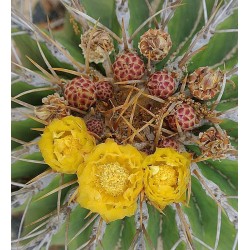
Graines de Mexique Barrel...
Prix
2,55 €
SKU: CT 20
Seeds Gallery Com,
5/
5
<h2><span style="font-size: 14pt;"><strong>Graines de Mexique Barrel Cactus (Ferocactus Schwarzii)</strong></span></h2>
<h2><span style="font-size: 14pt; color: #ff0000;"><strong>10 graines par sachet.</strong></span></h2>
<p>Ferocactus Schwarzii est un cactus à baril à croissance lente; jeune, il a des épines dorées, mais perd la plupart de ses épines quand il est plus âgé. Grandir jusqu'à 80 cm ou plus de hauteur, avec un diamètre d'environ 50 cm. Les fleurs jaune vif sont produites en été et mesurent 10 cm.</p>
<p> </p>
<p>Température minimale recommandée en hiver autour de 10 ° C</p>
CT 20 (10 S)


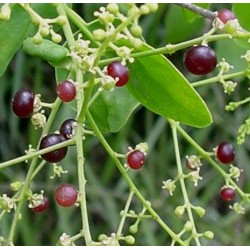
Graines de Brosse à Dents...
Prix
2,25 €
SKU: T 76
Seeds Gallery Com,
5/
5
<!DOCTYPE html>
<html>
<head>
<meta http-equiv="Content-Type" content="text/html; charset=UTF-8" />
</head>
<body>
<h2><span style="font-size: 14pt;"><strong>Graines de Brosse à Dents Moutarde Arbre (Salvadora persica)</strong></span></h2>
<h2><span style="font-size: 14pt; color: #ff0000;"><strong>5 graines par sachet.</strong></span></h2>
<p>Salvadora persica est un arbuste de la famille des Salvadoraceae, originaire du Moyen-Orient. Sa racine est utilisée comme moyen de nettoyage des dents et est appelée siwak.</p>
<p>le Shah ibn Shekyb sous le conseil du prêtre du temple d’Anahita à Istakhr l'utilisait dans tout l'empire sassanides en fin de l'antiquité pour des maux de tête. Cette plante a été utilisée en parallèle dans certaines sociétés celtique, dont le druide Thoutoueille qui en fait mention dans Táin Bó Cúailnge (Razzia des vaches de Cooley).</p>
<p>La brosse à dents arbre, salvadora Persica (d'autres noms galenia ASIATICA, salvadora Indica, "peelu" ou "pīlu"), est un petit arbre ou arbuste avec un tronc courbé, rarement plus d'un mètre de diamètre, son écorce scabrous et fissuré, blanchâtre avec pendulous extremites. Écorce de la racine de l'arbre est brun clair (comme avec de sable) et les surfaces internes sont de la même teinte brun, l'odeur est comme de cresson et son goût est chaleureux et fort. Ses branches ont été utilisés comme les brosses à dents fibreux de nombreuses communautés islamiques - miswaks. Il a été recommandé pour être utilisés avant chaque prière : "s'il ne sont pas trop d'une charge ensuite je voudrais raconter les croyants à utiliser le siwak avant chaque prière", il a été scientifiquement prouvé pour être très utile dans la prévention des caries, même lors de l'utilisation sans dentifrice à tout autre moyen.</p>
<h3><strong>Retirez la pulpe avant de semer.</strong></h3>
</body>
</html>
T 76

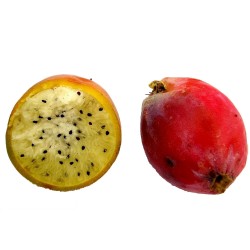
Graines de cactus Caracore...
Prix
1,85 €
SKU: CT 18
Seeds Gallery Com,
5/
5
<h2 class="MsoNormal" style="margin-bottom: .0001pt; line-height: normal;"><span class="tlid-translation" style="font-size: 14pt;"><b><span lang="fr" xml:lang="fr" class="">Graines de cactus Caracore (Cereus dayamii)</span></b></span></h2>
<h2 class="MsoNormal" style="margin-bottom: .0001pt; line-height: normal;"><span style="font-size: 14pt;"><b><span lang="fr" xml:lang="fr"><span style="color: #ff0000;">5 graines par sachet.</span></span></b></span></h2>
<p class="MsoNormal" style="margin-bottom: .0001pt; line-height: normal;"><b><span lang="fr" xml:lang="fr"><span style="color: #ff0000;"></span></span></b><span class="tlid-translation"><span lang="fr" xml:lang="fr">Cereus stenogonus est une espèce dans le genre Cereus (cactus de la patate douce) qui contient 20 espèces et fait partie de la famille des Cactaceae.</span></span><span lang="fr" xml:lang="fr"><br><br><span class="tlid-translation">Les arbres atteignent une hauteur d'environ 8 mètres.</span><br><br><span class="tlid-translation">Cereus stenogonus est une plante à feuilles persistantes. Les fleurs sont en forme d'entonnoir et rose. Les fleurs sont disposées solitaires.</span><br><span class="tlid-translation">Les fruits sont comestibles.</span><br><br><span class="tlid-translation"><b>Les usages</b></span><b><br></b><span class="tlid-translation">Les fruits et les tiges de Cereus repandus sont comestibles. Son bois a été utilisé pour la fabrication de meubles et pour le bois de chauffage, et des tiges tranchées ont été utilisées comme substitut de savon. Il est également cultivé comme une barrière vivante.</span><br><br><span class="tlid-translation">Cereus stenogonus provient de l'est de la Bolivie, du Paraguay et du nord de l'Argentine.</span><br><br><span class="tlid-translation">Cereus stenogonus préfère un site ensoleillé et peut supporter des températures allant jusqu'à -6,6 ° C.</span><br><span class="tlid-translation">Il pousse mieux dans les sols secs.</span></span></p>
<p></p>
<!-- [if gte mso 9]><xml>
<o:OfficeDocumentSettings>
<o:RelyOnVML/>
<o:AllowPNG/>
</o:OfficeDocumentSettings>
</xml><![endif]--><!-- [if gte mso 9]><xml>
<w:WordDocument>
<w:View>Normal</w:View>
<w:Zoom>0</w:Zoom>
<w:TrackMoves/>
<w:TrackFormatting/>
<w:PunctuationKerning/>
<w:ValidateAgainstSchemas/>
<w:SaveIfXMLInvalid>false</w:SaveIfXMLInvalid>
<w:IgnoreMixedContent>false</w:IgnoreMixedContent>
<w:AlwaysShowPlaceholderText>false</w:AlwaysShowPlaceholderText>
<w:DoNotPromoteQF/>
<w:LidThemeOther>EN-US</w:LidThemeOther>
<w:LidThemeAsian>X-NONE</w:LidThemeAsian>
<w:LidThemeComplexScript>X-NONE</w:LidThemeComplexScript>
<w:Compatibility>
<w:BreakWrappedTables/>
<w:SnapToGridInCell/>
<w:WrapTextWithPunct/>
<w:UseAsianBreakRules/>
<w:DontGrowAutofit/>
<w:SplitPgBreakAndParaMark/>
<w:EnableOpenTypeKerning/>
<w:DontFlipMirrorIndents/>
<w:OverrideTableStyleHps/>
</w:Compatibility>
<m:mathPr>
<m:mathFont m:val="Cambria Math"/>
<m:brkBin m:val="before"/>
<m:brkBinSub m:val="--"/>
<m:smallFrac m:val="off"/>
<m:dispDef/>
<m:lMargin m:val="0"/>
<m:rMargin m:val="0"/>
<m:defJc m:val="centerGroup"/>
<m:wrapIndent m:val="1440"/>
<m:intLim m:val="subSup"/>
<m:naryLim m:val="undOvr"/>
</m:mathPr></w:WordDocument>
</xml><![endif]--><!-- [if gte mso 9]><xml>
<w:LatentStyles DefLockedState="false" DefUnhideWhenUsed="false"
DefSemiHidden="false" DefQFormat="false" DefPriority="99"
LatentStyleCount="371">
<w:LsdException Locked="false" Priority="0" QFormat="true" Name="Normal"/>
<w:LsdException Locked="false" Priority="9" QFormat="true" Name="heading 1"/>
<w:LsdException Locked="false" Priority="9" SemiHidden="true"
UnhideWhenUsed="true" QFormat="true" Name="heading 2"/>
<w:LsdException Locked="false" Priority="9" SemiHidden="true"
UnhideWhenUsed="true" QFormat="true" Name="heading 3"/>
<w:LsdException Locked="false" Priority="9" SemiHidden="true"
UnhideWhenUsed="true" QFormat="true" Name="heading 4"/>
<w:LsdException Locked="false" Priority="9" SemiHidden="true"
UnhideWhenUsed="true" QFormat="true" Name="heading 5"/>
<w:LsdException Locked="false" Priority="9" SemiHidden="true"
UnhideWhenUsed="true" QFormat="true" Name="heading 6"/>
<w:LsdException Locked="false" Priority="9" SemiHidden="true"
UnhideWhenUsed="true" QFormat="true" Name="heading 7"/>
<w:LsdException Locked="false" Priority="9" SemiHidden="true"
UnhideWhenUsed="true" QFormat="true" Name="heading 8"/>
<w:LsdException Locked="false" Priority="9" SemiHidden="true"
UnhideWhenUsed="true" QFormat="true" Name="heading 9"/>
<w:LsdException Locked="false" SemiHidden="true" UnhideWhenUsed="true"
Name="index 1"/>
<w:LsdException Locked="false" SemiHidden="true" UnhideWhenUsed="true"
Name="index 2"/>
<w:LsdException Locked="false" SemiHidden="true" UnhideWhenUsed="true"
Name="index 3"/>
<w:LsdException Locked="false" SemiHidden="true" UnhideWhenUsed="true"
Name="index 4"/>
<w:LsdException Locked="false" SemiHidden="true" UnhideWhenUsed="true"
Name="index 5"/>
<w:LsdException Locked="false" SemiHidden="true" UnhideWhenUsed="true"
Name="index 6"/>
<w:LsdException Locked="false" SemiHidden="true" UnhideWhenUsed="true"
Name="index 7"/>
<w:LsdException Locked="false" SemiHidden="true" UnhideWhenUsed="true"
Name="index 8"/>
<w:LsdException Locked="false" SemiHidden="true" UnhideWhenUsed="true"
Name="index 9"/>
<w:LsdException Locked="false" Priority="39" SemiHidden="true"
UnhideWhenUsed="true" Name="toc 1"/>
<w:LsdException Locked="false" Priority="39" SemiHidden="true"
UnhideWhenUsed="true" Name="toc 2"/>
<w:LsdException Locked="false" Priority="39" SemiHidden="true"
UnhideWhenUsed="true" Name="toc 3"/>
<w:LsdException Locked="false" Priority="39" SemiHidden="true"
UnhideWhenUsed="true" Name="toc 4"/>
<w:LsdException Locked="false" Priority="39" SemiHidden="true"
UnhideWhenUsed="true" Name="toc 5"/>
<w:LsdException Locked="false" Priority="39" SemiHidden="true"
UnhideWhenUsed="true" Name="toc 6"/>
<w:LsdException Locked="false" Priority="39" SemiHidden="true"
UnhideWhenUsed="true" Name="toc 7"/>
<w:LsdException Locked="false" Priority="39" SemiHidden="true"
UnhideWhenUsed="true" Name="toc 8"/>
<w:LsdException Locked="false" Priority="39" SemiHidden="true"
UnhideWhenUsed="true" Name="toc 9"/>
<w:LsdException Locked="false" SemiHidden="true" UnhideWhenUsed="true"
Name="Normal Indent"/>
<w:LsdException Locked="false" SemiHidden="true" UnhideWhenUsed="true"
Name="footnote text"/>
<w:LsdException Locked="false" SemiHidden="true" UnhideWhenUsed="true"
Name="annotation text"/>
<w:LsdException Locked="false" SemiHidden="true" UnhideWhenUsed="true"
Name="header"/>
<w:LsdException Locked="false" SemiHidden="true" UnhideWhenUsed="true"
Name="footer"/>
<w:LsdException Locked="false" SemiHidden="true" UnhideWhenUsed="true"
Name="index heading"/>
<w:LsdException Locked="false" Priority="35" SemiHidden="true"
UnhideWhenUsed="true" QFormat="true" Name="caption"/>
<w:LsdException Locked="false" SemiHidden="true" UnhideWhenUsed="true"
Name="table of figures"/>
<w:LsdException Locked="false" SemiHidden="true" UnhideWhenUsed="true"
Name="envelope address"/>
<w:LsdException Locked="false" SemiHidden="true" UnhideWhenUsed="true"
Name="envelope return"/>
<w:LsdException Locked="false" SemiHidden="true" UnhideWhenUsed="true"
Name="footnote reference"/>
<w:LsdException Locked="false" SemiHidden="true" UnhideWhenUsed="true"
Name="annotation reference"/>
<w:LsdException Locked="false" SemiHidden="true" UnhideWhenUsed="true"
Name="line number"/>
<w:LsdException Locked="false" SemiHidden="true" UnhideWhenUsed="true"
Name="page number"/>
<w:LsdException Locked="false" SemiHidden="true" UnhideWhenUsed="true"
Name="endnote reference"/>
<w:LsdException Locked="false" SemiHidden="true" UnhideWhenUsed="true"
Name="endnote text"/>
<w:LsdException Locked="false" SemiHidden="true" UnhideWhenUsed="true"
Name="table of authorities"/>
<w:LsdException Locked="false" SemiHidden="true" UnhideWhenUsed="true"
Name="macro"/>
<w:LsdException Locked="false" SemiHidden="true" UnhideWhenUsed="true"
Name="toa heading"/>
<w:LsdException Locked="false" SemiHidden="true" UnhideWhenUsed="true"
Name="List"/>
<w:LsdException Locked="false" SemiHidden="true" UnhideWhenUsed="true"
Name="List Bullet"/>
<w:LsdException Locked="false" SemiHidden="true" UnhideWhenUsed="true"
Name="List Number"/>
<w:LsdException Locked="false" SemiHidden="true" UnhideWhenUsed="true"
Name="List 2"/>
<w:LsdException Locked="false" SemiHidden="true" UnhideWhenUsed="true"
Name="List 3"/>
<w:LsdException Locked="false" SemiHidden="true" UnhideWhenUsed="true"
Name="List 4"/>
<w:LsdException Locked="false" SemiHidden="true" UnhideWhenUsed="true"
Name="List 5"/>
<w:LsdException Locked="false" SemiHidden="true" UnhideWhenUsed="true"
Name="List Bullet 2"/>
<w:LsdException Locked="false" SemiHidden="true" UnhideWhenUsed="true"
Name="List Bullet 3"/>
<w:LsdException Locked="false" SemiHidden="true" UnhideWhenUsed="true"
Name="List Bullet 4"/>
<w:LsdException Locked="false" SemiHidden="true" UnhideWhenUsed="true"
Name="List Bullet 5"/>
<w:LsdException Locked="false" SemiHidden="true" UnhideWhenUsed="true"
Name="List Number 2"/>
<w:LsdException Locked="false" SemiHidden="true" UnhideWhenUsed="true"
Name="List Number 3"/>
<w:LsdException Locked="false" SemiHidden="true" UnhideWhenUsed="true"
Name="List Number 4"/>
<w:LsdException Locked="false" SemiHidden="true" UnhideWhenUsed="true"
Name="List Number 5"/>
<w:LsdException Locked="false" Priority="10" QFormat="true" Name="Title"/>
<w:LsdException Locked="false" SemiHidden="true" UnhideWhenUsed="true"
Name="Closing"/>
<w:LsdException Locked="false" SemiHidden="true" UnhideWhenUsed="true"
Name="Signature"/>
<w:LsdException Locked="false" Priority="1" SemiHidden="true"
UnhideWhenUsed="true" Name="Default Paragraph Font"/>
<w:LsdException Locked="false" SemiHidden="true" UnhideWhenUsed="true"
Name="Body Text"/>
<w:LsdException Locked="false" SemiHidden="true" UnhideWhenUsed="true"
Name="Body Text Indent"/>
<w:LsdException Locked="false" SemiHidden="true" UnhideWhenUsed="true"
Name="List Continue"/>
<w:LsdException Locked="false" SemiHidden="true" UnhideWhenUsed="true"
Name="List Continue 2"/>
<w:LsdException Locked="false" SemiHidden="true" UnhideWhenUsed="true"
Name="List Continue 3"/>
<w:LsdException Locked="false" SemiHidden="true" UnhideWhenUsed="true"
Name="List Continue 4"/>
<w:LsdException Locked="false" SemiHidden="true" UnhideWhenUsed="true"
Name="List Continue 5"/>
<w:LsdException Locked="false" SemiHidden="true" UnhideWhenUsed="true"
Name="Message Header"/>
<w:LsdException Locked="false" Priority="11" QFormat="true" Name="Subtitle"/>
<w:LsdException Locked="false" SemiHidden="true" UnhideWhenUsed="true"
Name="Salutation"/>
<w:LsdException Locked="false" SemiHidden="true" UnhideWhenUsed="true"
Name="Date"/>
<w:LsdException Locked="false" SemiHidden="true" UnhideWhenUsed="true"
Name="Body Text First Indent"/>
<w:LsdException Locked="false" SemiHidden="true" UnhideWhenUsed="true"
Name="Body Text First Indent 2"/>
<w:LsdException Locked="false" SemiHidden="true" UnhideWhenUsed="true"
Name="Note Heading"/>
<w:LsdException Locked="false" SemiHidden="true" UnhideWhenUsed="true"
Name="Body Text 2"/>
<w:LsdException Locked="false" SemiHidden="true" UnhideWhenUsed="true"
Name="Body Text 3"/>
<w:LsdException Locked="false" SemiHidden="true" UnhideWhenUsed="true"
Name="Body Text Indent 2"/>
<w:LsdException Locked="false" SemiHidden="true" UnhideWhenUsed="true"
Name="Body Text Indent 3"/>
<w:LsdException Locked="false" SemiHidden="true" UnhideWhenUsed="true"
Name="Block Text"/>
<w:LsdException Locked="false" SemiHidden="true" UnhideWhenUsed="true"
Name="Hyperlink"/>
<w:LsdException Locked="false" SemiHidden="true" UnhideWhenUsed="true"
Name="FollowedHyperlink"/>
<w:LsdException Locked="false" Priority="22" QFormat="true" Name="Strong"/>
<w:LsdException Locked="false" Priority="20" QFormat="true" Name="Emphasis"/>
<w:LsdException Locked="false" SemiHidden="true" UnhideWhenUsed="true"
Name="Document Map"/>
<w:LsdException Locked="false" SemiHidden="true" UnhideWhenUsed="true"
Name="Plain Text"/>
<w:LsdException Locked="false" SemiHidden="true" UnhideWhenUsed="true"
Name="E-mail Signature"/>
<w:LsdException Locked="false" SemiHidden="true" UnhideWhenUsed="true"
Name="HTML Top of Form"/>
<w:LsdException Locked="false" SemiHidden="true" UnhideWhenUsed="true"
Name="HTML Bottom of Form"/>
<w:LsdException Locked="false" SemiHidden="true" UnhideWhenUsed="true"
Name="Normal (Web)"/>
<w:LsdException Locked="false" SemiHidden="true" UnhideWhenUsed="true"
Name="HTML Acronym"/>
<w:LsdException Locked="false" SemiHidden="true" UnhideWhenUsed="true"
Name="HTML Address"/>
<w:LsdException Locked="false" SemiHidden="true" UnhideWhenUsed="true"
Name="HTML Cite"/>
<w:LsdException Locked="false" SemiHidden="true" UnhideWhenUsed="true"
Name="HTML Code"/>
<w:LsdException Locked="false" SemiHidden="true" UnhideWhenUsed="true"
Name="HTML Definition"/>
<w:LsdException Locked="false" SemiHidden="true" UnhideWhenUsed="true"
Name="HTML Keyboard"/>
<w:LsdException Locked="false" SemiHidden="true" UnhideWhenUsed="true"
Name="HTML Preformatted"/>
<w:LsdException Locked="false" SemiHidden="true" UnhideWhenUsed="true"
Name="HTML Sample"/>
<w:LsdException Locked="false" SemiHidden="true" UnhideWhenUsed="true"
Name="HTML Typewriter"/>
<w:LsdException Locked="false" SemiHidden="true" UnhideWhenUsed="true"
Name="HTML Variable"/>
<w:LsdException Locked="false" SemiHidden="true" UnhideWhenUsed="true"
Name="Normal Table"/>
<w:LsdException Locked="false" SemiHidden="true" UnhideWhenUsed="true"
Name="annotation subject"/>
<w:LsdException Locked="false" SemiHidden="true" UnhideWhenUsed="true"
Name="No List"/>
<w:LsdException Locked="false" SemiHidden="true" UnhideWhenUsed="true"
Name="Outline List 1"/>
<w:LsdException Locked="false" SemiHidden="true" UnhideWhenUsed="true"
Name="Outline List 2"/>
<w:LsdException Locked="false" SemiHidden="true" UnhideWhenUsed="true"
Name="Outline List 3"/>
<w:LsdException Locked="false" SemiHidden="true" UnhideWhenUsed="true"
Name="Table Simple 1"/>
<w:LsdException Locked="false" SemiHidden="true" UnhideWhenUsed="true"
Name="Table Simple 2"/>
<w:LsdException Locked="false" SemiHidden="true" UnhideWhenUsed="true"
Name="Table Simple 3"/>
<w:LsdException Locked="false" SemiHidden="true" UnhideWhenUsed="true"
Name="Table Classic 1"/>
<w:LsdException Locked="false" SemiHidden="true" UnhideWhenUsed="true"
Name="Table Classic 2"/>
<w:LsdException Locked="false" SemiHidden="true" UnhideWhenUsed="true"
Name="Table Classic 3"/>
<w:LsdException Locked="false" SemiHidden="true" UnhideWhenUsed="true"
Name="Table Classic 4"/>
<w:LsdException Locked="false" SemiHidden="true" UnhideWhenUsed="true"
Name="Table Colorful 1"/>
<w:LsdException Locked="false" SemiHidden="true" UnhideWhenUsed="true"
Name="Table Colorful 2"/>
<w:LsdException Locked="false" SemiHidden="true" UnhideWhenUsed="true"
Name="Table Colorful 3"/>
<w:LsdException Locked="false" SemiHidden="true" UnhideWhenUsed="true"
Name="Table Columns 1"/>
<w:LsdException Locked="false" SemiHidden="true" UnhideWhenUsed="true"
Name="Table Columns 2"/>
<w:LsdException Locked="false" SemiHidden="true" UnhideWhenUsed="true"
Name="Table Columns 3"/>
<w:LsdException Locked="false" SemiHidden="true" UnhideWhenUsed="true"
Name="Table Columns 4"/>
<w:LsdException Locked="false" SemiHidden="true" UnhideWhenUsed="true"
Name="Table Columns 5"/>
<w:LsdException Locked="false" SemiHidden="true" UnhideWhenUsed="true"
Name="Table Grid 1"/>
<w:LsdException Locked="false" SemiHidden="true" UnhideWhenUsed="true"
Name="Table Grid 2"/>
<w:LsdException Locked="false" SemiHidden="true" UnhideWhenUsed="true"
Name="Table Grid 3"/>
<w:LsdException Locked="false" SemiHidden="true" UnhideWhenUsed="true"
Name="Table Grid 4"/>
<w:LsdException Locked="false" SemiHidden="true" UnhideWhenUsed="true"
Name="Table Grid 5"/>
<w:LsdException Locked="false" SemiHidden="true" UnhideWhenUsed="true"
Name="Table Grid 6"/>
<w:LsdException Locked="false" SemiHidden="true" UnhideWhenUsed="true"
Name="Table Grid 7"/>
<w:LsdException Locked="false" SemiHidden="true" UnhideWhenUsed="true"
Name="Table Grid 8"/>
<w:LsdException Locked="false" SemiHidden="true" UnhideWhenUsed="true"
Name="Table List 1"/>
<w:LsdException Locked="false" SemiHidden="true" UnhideWhenUsed="true"
Name="Table List 2"/>
<w:LsdException Locked="false" SemiHidden="true" UnhideWhenUsed="true"
Name="Table List 3"/>
<w:LsdException Locked="false" SemiHidden="true" UnhideWhenUsed="true"
Name="Table List 4"/>
<w:LsdException Locked="false" SemiHidden="true" UnhideWhenUsed="true"
Name="Table List 5"/>
<w:LsdException Locked="false" SemiHidden="true" UnhideWhenUsed="true"
Name="Table List 6"/>
<w:LsdException Locked="false" SemiHidden="true" UnhideWhenUsed="true"
Name="Table List 7"/>
<w:LsdException Locked="false" SemiHidden="true" UnhideWhenUsed="true"
Name="Table List 8"/>
<w:LsdException Locked="false" SemiHidden="true" UnhideWhenUsed="true"
Name="Table 3D effects 1"/>
<w:LsdException Locked="false" SemiHidden="true" UnhideWhenUsed="true"
Name="Table 3D effects 2"/>
<w:LsdException Locked="false" SemiHidden="true" UnhideWhenUsed="true"
Name="Table 3D effects 3"/>
<w:LsdException Locked="false" SemiHidden="true" UnhideWhenUsed="true"
Name="Table Contemporary"/>
<w:LsdException Locked="false" SemiHidden="true" UnhideWhenUsed="true"
Name="Table Elegant"/>
<w:LsdException Locked="false" SemiHidden="true" UnhideWhenUsed="true"
Name="Table Professional"/>
<w:LsdException Locked="false" SemiHidden="true" UnhideWhenUsed="true"
Name="Table Subtle 1"/>
<w:LsdException Locked="false" SemiHidden="true" UnhideWhenUsed="true"
Name="Table Subtle 2"/>
<w:LsdException Locked="false" SemiHidden="true" UnhideWhenUsed="true"
Name="Table Web 1"/>
<w:LsdException Locked="false" SemiHidden="true" UnhideWhenUsed="true"
Name="Table Web 2"/>
<w:LsdException Locked="false" SemiHidden="true" UnhideWhenUsed="true"
Name="Table Web 3"/>
<w:LsdException Locked="false" SemiHidden="true" UnhideWhenUsed="true"
Name="Balloon Text"/>
<w:LsdException Locked="false" Priority="39" Name="Table Grid"/>
<w:LsdException Locked="false" SemiHidden="true" UnhideWhenUsed="true"
Name="Table Theme"/>
<w:LsdException Locked="false" SemiHidden="true" Name="Placeholder Text"/>
<w:LsdException Locked="false" Priority="1" QFormat="true" Name="No Spacing"/>
<w:LsdException Locked="false" Priority="60" Name="Light Shading"/>
<w:LsdException Locked="false" Priority="61" Name="Light List"/>
<w:LsdException Locked="false" Priority="62" Name="Light Grid"/>
<w:LsdException Locked="false" Priority="63" Name="Medium Shading 1"/>
<w:LsdException Locked="false" Priority="64" Name="Medium Shading 2"/>
<w:LsdException Locked="false" Priority="65" Name="Medium List 1"/>
<w:LsdException Locked="false" Priority="66" Name="Medium List 2"/>
<w:LsdException Locked="false" Priority="67" Name="Medium Grid 1"/>
<w:LsdException Locked="false" Priority="68" Name="Medium Grid 2"/>
<w:LsdException Locked="false" Priority="69" Name="Medium Grid 3"/>
<w:LsdException Locked="false" Priority="70" Name="Dark List"/>
<w:LsdException Locked="false" Priority="71" Name="Colorful Shading"/>
<w:LsdException Locked="false" Priority="72" Name="Colorful List"/>
<w:LsdException Locked="false" Priority="73" Name="Colorful Grid"/>
<w:LsdException Locked="false" Priority="60" Name="Light Shading Accent 1"/>
<w:LsdException Locked="false" Priority="61" Name="Light List Accent 1"/>
<w:LsdException Locked="false" Priority="62" Name="Light Grid Accent 1"/>
<w:LsdException Locked="false" Priority="63" Name="Medium Shading 1 Accent 1"/>
<w:LsdException Locked="false" Priority="64" Name="Medium Shading 2 Accent 1"/>
<w:LsdException Locked="false" Priority="65" Name="Medium List 1 Accent 1"/>
<w:LsdException Locked="false" SemiHidden="true" Name="Revision"/>
<w:LsdException Locked="false" Priority="34" QFormat="true"
Name="List Paragraph"/>
<w:LsdException Locked="false" Priority="29" QFormat="true" Name="Quote"/>
<w:LsdException Locked="false" Priority="30" QFormat="true"
Name="Intense Quote"/>
<w:LsdException Locked="false" Priority="66" Name="Medium List 2 Accent 1"/>
<w:LsdException Locked="false" Priority="67" Name="Medium Grid 1 Accent 1"/>
<w:LsdException Locked="false" Priority="68" Name="Medium Grid 2 Accent 1"/>
<w:LsdException Locked="false" Priority="69" Name="Medium Grid 3 Accent 1"/>
<w:LsdException Locked="false" Priority="70" Name="Dark List Accent 1"/>
<w:LsdException Locked="false" Priority="71" Name="Colorful Shading Accent 1"/>
<w:LsdException Locked="false" Priority="72" Name="Colorful List Accent 1"/>
<w:LsdException Locked="false" Priority="73" Name="Colorful Grid Accent 1"/>
<w:LsdException Locked="false" Priority="60" Name="Light Shading Accent 2"/>
<w:LsdException Locked="false" Priority="61" Name="Light List Accent 2"/>
<w:LsdException Locked="false" Priority="62" Name="Light Grid Accent 2"/>
<w:LsdException Locked="false" Priority="63" Name="Medium Shading 1 Accent 2"/>
<w:LsdException Locked="false" Priority="64" Name="Medium Shading 2 Accent 2"/>
<w:LsdException Locked="false" Priority="65" Name="Medium List 1 Accent 2"/>
<w:LsdException Locked="false" Priority="66" Name="Medium List 2 Accent 2"/>
<w:LsdException Locked="false" Priority="67" Name="Medium Grid 1 Accent 2"/>
<w:LsdException Locked="false" Priority="68" Name="Medium Grid 2 Accent 2"/>
<w:LsdException Locked="false" Priority="69" Name="Medium Grid 3 Accent 2"/>
<w:LsdException Locked="false" Priority="70" Name="Dark List Accent 2"/>
<w:LsdException Locked="false" Priority="71" Name="Colorful Shading Accent 2"/>
<w:LsdException Locked="false" Priority="72" Name="Colorful List Accent 2"/>
<w:LsdException Locked="false" Priority="73" Name="Colorful Grid Accent 2"/>
<w:LsdException Locked="false" Priority="60" Name="Light Shading Accent 3"/>
<w:LsdException Locked="false" Priority="61" Name="Light List Accent 3"/>
<w:LsdException Locked="false" Priority="62" Name="Light Grid Accent 3"/>
<w:LsdException Locked="false" Priority="63" Name="Medium Shading 1 Accent 3"/>
<w:LsdException Locked="false" Priority="64" Name="Medium Shading 2 Accent 3"/>
<w:LsdException Locked="false" Priority="65" Name="Medium List 1 Accent 3"/>
<w:LsdException Locked="false" Priority="66" Name="Medium List 2 Accent 3"/>
<w:LsdException Locked="false" Priority="67" Name="Medium Grid 1 Accent 3"/>
<w:LsdException Locked="false" Priority="68" Name="Medium Grid 2 Accent 3"/>
<w:LsdException Locked="false" Priority="69" Name="Medium Grid 3 Accent 3"/>
<w:LsdException Locked="false" Priority="70" Name="Dark List Accent 3"/>
<w:LsdException Locked="false" Priority="71" Name="Colorful Shading Accent 3"/>
<w:LsdException Locked="false" Priority="72" Name="Colorful List Accent 3"/>
<w:LsdException Locked="false" Priority="73" Name="Colorful Grid Accent 3"/>
<w:LsdException Locked="false" Priority="60" Name="Light Shading Accent 4"/>
<w:LsdException Locked="false" Priority="61" Name="Light List Accent 4"/>
<w:LsdException Locked="false" Priority="62" Name="Light Grid Accent 4"/>
<w:LsdException Locked="false" Priority="63" Name="Medium Shading 1 Accent 4"/>
<w:LsdException Locked="false" Priority="64" Name="Medium Shading 2 Accent 4"/>
<w:LsdException Locked="false" Priority="65" Name="Medium List 1 Accent 4"/>
<w:LsdException Locked="false" Priority="66" Name="Medium List 2 Accent 4"/>
<w:LsdException Locked="false" Priority="67" Name="Medium Grid 1 Accent 4"/>
<w:LsdException Locked="false" Priority="68" Name="Medium Grid 2 Accent 4"/>
<w:LsdException Locked="false" Priority="69" Name="Medium Grid 3 Accent 4"/>
<w:LsdException Locked="false" Priority="70" Name="Dark List Accent 4"/>
<w:LsdException Locked="false" Priority="71" Name="Colorful Shading Accent 4"/>
<w:LsdException Locked="false" Priority="72" Name="Colorful List Accent 4"/>
<w:LsdException Locked="false" Priority="73" Name="Colorful Grid Accent 4"/>
<w:LsdException Locked="false" Priority="60" Name="Light Shading Accent 5"/>
<w:LsdException Locked="false" Priority="61" Name="Light List Accent 5"/>
<w:LsdException Locked="false" Priority="62" Name="Light Grid Accent 5"/>
<w:LsdException Locked="false" Priority="63" Name="Medium Shading 1 Accent 5"/>
<w:LsdException Locked="false" Priority="64" Name="Medium Shading 2 Accent 5"/>
<w:LsdException Locked="false" Priority="65" Name="Medium List 1 Accent 5"/>
<w:LsdException Locked="false" Priority="66" Name="Medium List 2 Accent 5"/>
<w:LsdException Locked="false" Priority="67" Name="Medium Grid 1 Accent 5"/>
<w:LsdException Locked="false" Priority="68" Name="Medium Grid 2 Accent 5"/>
<w:LsdException Locked="false" Priority="69" Name="Medium Grid 3 Accent 5"/>
<w:LsdException Locked="false" Priority="70" Name="Dark List Accent 5"/>
<w:LsdException Locked="false" Priority="71" Name="Colorful Shading Accent 5"/>
<w:LsdException Locked="false" Priority="72" Name="Colorful List Accent 5"/>
<w:LsdException Locked="false" Priority="73" Name="Colorful Grid Accent 5"/>
<w:LsdException Locked="false" Priority="60" Name="Light Shading Accent 6"/>
<w:LsdException Locked="false" Priority="61" Name="Light List Accent 6"/>
<w:LsdException Locked="false" Priority="62" Name="Light Grid Accent 6"/>
<w:LsdException Locked="false" Priority="63" Name="Medium Shading 1 Accent 6"/>
<w:LsdException Locked="false" Priority="64" Name="Medium Shading 2 Accent 6"/>
<w:LsdException Locked="false" Priority="65" Name="Medium List 1 Accent 6"/>
<w:LsdException Locked="false" Priority="66" Name="Medium List 2 Accent 6"/>
<w:LsdException Locked="false" Priority="67" Name="Medium Grid 1 Accent 6"/>
<w:LsdException Locked="false" Priority="68" Name="Medium Grid 2 Accent 6"/>
<w:LsdException Locked="false" Priority="69" Name="Medium Grid 3 Accent 6"/>
<w:LsdException Locked="false" Priority="70" Name="Dark List Accent 6"/>
<w:LsdException Locked="false" Priority="71" Name="Colorful Shading Accent 6"/>
<w:LsdException Locked="false" Priority="72" Name="Colorful List Accent 6"/>
<w:LsdException Locked="false" Priority="73" Name="Colorful Grid Accent 6"/>
<w:LsdException Locked="false" Priority="19" QFormat="true"
Name="Subtle Emphasis"/>
<w:LsdException Locked="false" Priority="21" QFormat="true"
Name="Intense Emphasis"/>
<w:LsdException Locked="false" Priority="31" QFormat="true"
Name="Subtle Reference"/>
<w:LsdException Locked="false" Priority="32" QFormat="true"
Name="Intense Reference"/>
<w:LsdException Locked="false" Priority="33" QFormat="true" Name="Book Title"/>
<w:LsdException Locked="false" Priority="37" SemiHidden="true"
UnhideWhenUsed="true" Name="Bibliography"/>
<w:LsdException Locked="false" Priority="39" SemiHidden="true"
UnhideWhenUsed="true" QFormat="true" Name="TOC Heading"/>
<w:LsdException Locked="false" Priority="41" Name="Plain Table 1"/>
<w:LsdException Locked="false" Priority="42" Name="Plain Table 2"/>
<w:LsdException Locked="false" Priority="43" Name="Plain Table 3"/>
<w:LsdException Locked="false" Priority="44" Name="Plain Table 4"/>
<w:LsdException Locked="false" Priority="45" Name="Plain Table 5"/>
<w:LsdException Locked="false" Priority="40" Name="Grid Table Light"/>
<w:LsdException Locked="false" Priority="46" Name="Grid Table 1 Light"/>
<w:LsdException Locked="false" Priority="47" Name="Grid Table 2"/>
<w:LsdException Locked="false" Priority="48" Name="Grid Table 3"/>
<w:LsdException Locked="false" Priority="49" Name="Grid Table 4"/>
<w:LsdException Locked="false" Priority="50" Name="Grid Table 5 Dark"/>
<w:LsdException Locked="false" Priority="51" Name="Grid Table 6 Colorful"/>
<w:LsdException Locked="false" Priority="52" Name="Grid Table 7 Colorful"/>
<w:LsdException Locked="false" Priority="46"
Name="Grid Table 1 Light Accent 1"/>
<w:LsdException Locked="false" Priority="47" Name="Grid Table 2 Accent 1"/>
<w:LsdException Locked="false" Priority="48" Name="Grid Table 3 Accent 1"/>
<w:LsdException Locked="false" Priority="49" Name="Grid Table 4 Accent 1"/>
<w:LsdException Locked="false" Priority="50" Name="Grid Table 5 Dark Accent 1"/>
<w:LsdException Locked="false" Priority="51"
Name="Grid Table 6 Colorful Accent 1"/>
<w:LsdException Locked="false" Priority="52"
Name="Grid Table 7 Colorful Accent 1"/>
<w:LsdException Locked="false" Priority="46"
Name="Grid Table 1 Light Accent 2"/>
<w:LsdException Locked="false" Priority="47" Name="Grid Table 2 Accent 2"/>
<w:LsdException Locked="false" Priority="48" Name="Grid Table 3 Accent 2"/>
<w:LsdException Locked="false" Priority="49" Name="Grid Table 4 Accent 2"/>
<w:LsdException Locked="false" Priority="50" Name="Grid Table 5 Dark Accent 2"/>
<w:LsdException Locked="false" Priority="51"
Name="Grid Table 6 Colorful Accent 2"/>
<w:LsdException Locked="false" Priority="52"
Name="Grid Table 7 Colorful Accent 2"/>
<w:LsdException Locked="false" Priority="46"
Name="Grid Table 1 Light Accent 3"/>
<w:LsdException Locked="false" Priority="47" Name="Grid Table 2 Accent 3"/>
<w:LsdException Locked="false" Priority="48" Name="Grid Table 3 Accent 3"/>
<w:LsdException Locked="false" Priority="49" Name="Grid Table 4 Accent 3"/>
<w:LsdException Locked="false" Priority="50" Name="Grid Table 5 Dark Accent 3"/>
<w:LsdException Locked="false" Priority="51"
Name="Grid Table 6 Colorful Accent 3"/>
<w:LsdException Locked="false" Priority="52"
Name="Grid Table 7 Colorful Accent 3"/>
<w:LsdException Locked="false" Priority="46"
Name="Grid Table 1 Light Accent 4"/>
<w:LsdException Locked="false" Priority="47" Name="Grid Table 2 Accent 4"/>
<w:LsdException Locked="false" Priority="48" Name="Grid Table 3 Accent 4"/>
<w:LsdException Locked="false" Priority="49" Name="Grid Table 4 Accent 4"/>
<w:LsdException Locked="false" Priority="50" Name="Grid Table 5 Dark Accent 4"/>
<w:LsdException Locked="false" Priority="51"
Name="Grid Table 6 Colorful Accent 4"/>
<w:LsdException Locked="false" Priority="52"
Name="Grid Table 7 Colorful Accent 4"/>
<w:LsdException Locked="false" Priority="46"
Name="Grid Table 1 Light Accent 5"/>
<w:LsdException Locked="false" Priority="47" Name="Grid Table 2 Accent 5"/>
<w:LsdException Locked="false" Priority="48" Name="Grid Table 3 Accent 5"/>
<w:LsdException Locked="false" Priority="49" Name="Grid Table 4 Accent 5"/>
<w:LsdException Locked="false" Priority="50" Name="Grid Table 5 Dark Accent 5"/>
<w:LsdException Locked="false" Priority="51"
Name="Grid Table 6 Colorful Accent 5"/>
<w:LsdException Locked="false" Priority="52"
Name="Grid Table 7 Colorful Accent 5"/>
<w:LsdException Locked="false" Priority="46"
Name="Grid Table 1 Light Accent 6"/>
<w:LsdException Locked="false" Priority="47" Name="Grid Table 2 Accent 6"/>
<w:LsdException Locked="false" Priority="48" Name="Grid Table 3 Accent 6"/>
<w:LsdException Locked="false" Priority="49" Name="Grid Table 4 Accent 6"/>
<w:LsdException Locked="false" Priority="50" Name="Grid Table 5 Dark Accent 6"/>
<w:LsdException Locked="false" Priority="51"
Name="Grid Table 6 Colorful Accent 6"/>
<w:LsdException Locked="false" Priority="52"
Name="Grid Table 7 Colorful Accent 6"/>
<w:LsdException Locked="false" Priority="46" Name="List Table 1 Light"/>
<w:LsdException Locked="false" Priority="47" Name="List Table 2"/>
<w:LsdException Locked="false" Priority="48" Name="List Table 3"/>
<w:LsdException Locked="false" Priority="49" Name="List Table 4"/>
<w:LsdException Locked="false" Priority="50" Name="List Table 5 Dark"/>
<w:LsdException Locked="false" Priority="51" Name="List Table 6 Colorful"/>
<w:LsdException Locked="false" Priority="52" Name="List Table 7 Colorful"/>
<w:LsdException Locked="false" Priority="46"
Name="List Table 1 Light Accent 1"/>
<w:LsdException Locked="false" Priority="47" Name="List Table 2 Accent 1"/>
<w:LsdException Locked="false" Priority="48" Name="List Table 3 Accent 1"/>
<w:LsdException Locked="false" Priority="49" Name="List Table 4 Accent 1"/>
<w:LsdException Locked="false" Priority="50" Name="List Table 5 Dark Accent 1"/>
<w:LsdException Locked="false" Priority="51"
Name="List Table 6 Colorful Accent 1"/>
<w:LsdException Locked="false" Priority="52"
Name="List Table 7 Colorful Accent 1"/>
<w:LsdException Locked="false" Priority="46"
Name="List Table 1 Light Accent 2"/>
<w:LsdException Locked="false" Priority="47" Name="List Table 2 Accent 2"/>
<w:LsdException Locked="false" Priority="48" Name="List Table 3 Accent 2"/>
<w:LsdException Locked="false" Priority="49" Name="List Table 4 Accent 2"/>
<w:LsdException Locked="false" Priority="50" Name="List Table 5 Dark Accent 2"/>
<w:LsdException Locked="false" Priority="51"
Name="List Table 6 Colorful Accent 2"/>
<w:LsdException Locked="false" Priority="52"
Name="List Table 7 Colorful Accent 2"/>
<w:LsdException Locked="false" Priority="46"
Name="List Table 1 Light Accent 3"/>
<w:LsdException Locked="false" Priority="47" Name="List Table 2 Accent 3"/>
<w:LsdException Locked="false" Priority="48" Name="List Table 3 Accent 3"/>
<w:LsdException Locked="false" Priority="49" Name="List Table 4 Accent 3"/>
<w:LsdException Locked="false" Priority="50" Name="List Table 5 Dark Accent 3"/>
<w:LsdException Locked="false" Priority="51"
Name="List Table 6 Colorful Accent 3"/>
<w:LsdException Locked="false" Priority="52"
Name="List Table 7 Colorful Accent 3"/>
<w:LsdException Locked="false" Priority="46"
Name="List Table 1 Light Accent 4"/>
<w:LsdException Locked="false" Priority="47" Name="List Table 2 Accent 4"/>
<w:LsdException Locked="false" Priority="48" Name="List Table 3 Accent 4"/>
<w:LsdException Locked="false" Priority="49" Name="List Table 4 Accent 4"/>
<w:LsdException Locked="false" Priority="50" Name="List Table 5 Dark Accent 4"/>
<w:LsdException Locked="false" Priority="51"
Name="List Table 6 Colorful Accent 4"/>
<w:LsdException Locked="false" Priority="52"
Name="List Table 7 Colorful Accent 4"/>
<w:LsdException Locked="false" Priority="46"
Name="List Table 1 Light Accent 5"/>
<w:LsdException Locked="false" Priority="47" Name="List Table 2 Accent 5"/>
<w:LsdException Locked="false" Priority="48" Name="List Table 3 Accent 5"/>
<w:LsdException Locked="false" Priority="49" Name="List Table 4 Accent 5"/>
<w:LsdException Locked="false" Priority="50" Name="List Table 5 Dark Accent 5"/>
<w:LsdException Locked="false" Priority="51"
Name="List Table 6 Colorful Accent 5"/>
<w:LsdException Locked="false" Priority="52"
Name="List Table 7 Colorful Accent 5"/>
<w:LsdException Locked="false" Priority="46"
Name="List Table 1 Light Accent 6"/>
<w:LsdException Locked="false" Priority="47" Name="List Table 2 Accent 6"/>
<w:LsdException Locked="false" Priority="48" Name="List Table 3 Accent 6"/>
<w:LsdException Locked="false" Priority="49" Name="List Table 4 Accent 6"/>
<w:LsdException Locked="false" Priority="50" Name="List Table 5 Dark Accent 6"/>
<w:LsdException Locked="false" Priority="51"
Name="List Table 6 Colorful Accent 6"/>
<w:LsdException Locked="false" Priority="52"
Name="List Table 7 Colorful Accent 6"/>
</w:LatentStyles>
</xml><![endif]--><!-- [if gte mso 10]>
<style>
/* Style Definitions */
table.MsoNormalTable
{mso-style-name:"Normale Tabelle";
mso-tstyle-rowband-size:0;
mso-tstyle-colband-size:0;
mso-style-noshow:yes;
mso-style-priority:99;
mso-style-parent:"";
mso-padding-alt:0in 5.4pt 0in 5.4pt;
mso-para-margin-top:0in;
mso-para-margin-right:0in;
mso-para-margin-bottom:8.0pt;
mso-para-margin-left:0in;
line-height:107%;
mso-pagination:widow-orphan;
font-size:11.0pt;
font-family:"Calibri",sans-serif;
mso-ascii-font-family:Calibri;
mso-ascii-theme-font:minor-latin;
mso-hansi-font-family:Calibri;
mso-hansi-theme-font:minor-latin;}
</style>
<![endif]-->
CT 18 (5 S)






